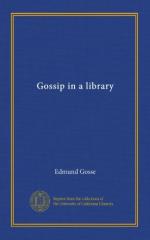The author of the Britannia, to justify his new advancement, had introduced into a fresh edition of his book a good deal of information regarding the descent of barons and other noble families. This was York Herald’s own subject, and he was able to convict Camden of a startling number of negligences, and what he calls “many gross mistakings.” The worst part of it was that York Herald had privately pointed out these blunders to Camden, and that the latter had said it was too much trouble to alter them. This, at least, is what the enemy states in his attack, and if this be true, it can hardly be doubled that Camden had sailed too long in fair weather, or that he needed a squall to recall him to the duties of the helm. He answered Brooke, who replied with increased contemptuous tartness. It is admitted that Camden was indiscreet in his manner of reply, and that some genuine holes had been pricked in his heraldry. But the Britannia lay high out of the reach of fatal pedantic attack, and this little cloud over the reputation of the book passed entirely away, and is remembered now only as a curiosity of literature.
In the preface the author quaintly admits that “many have found a defect in this work that maps were not adjoined, which do allure the eyes by pleasant portraitures, ... yet my ability could not compass it.” They must, then, have been added at the last by a generous afterthought, for this book is full of maps. The maritime ones are adorned with ships in full sail, and bold sea-monsters with curly tails; the inland ones are speckled with trees and spires and hillocks. In spite of these old-fashioned oddities, the maps are remarkably accurate. They are signed by John Norden and William Kip, the master map-makers of that reign. The book opens with an account of the first inhabitants of Britain, and their manners and customs; how the Romans fared, and what antiquities they left behind, with copious plates of Roman coins. By degrees we come down, through Saxons and Normans, to that work which was peculiarly Camden’s, the topographical antiquarianism. He begins with Cornwall, “that region which, according to the geographers, is the first of all Britain,” and then proceeds to what he calls “Denshire” and we Devonshire, a county, as he remarks, “barbarous on either side.”
With page 822 he finds himself at the end of his last English county, Northumberland, looking across the Tweed to Berwick, “the strongest hold in all Britain,” where it is “no marvel that soldiers without other light do play here all night long at dice, considering the side light that the sunbeams cast all night long.” This rather exaggerated statement is evidently that of a man accustomed to look upon Berwick as the northernmost point of his country, as we shall all do, no doubt, when Scotland has secured Home Rule. We are, therefore, not surprised to find Scotland added, in a kind of hurried appendix, in special honour to James I and VI.




